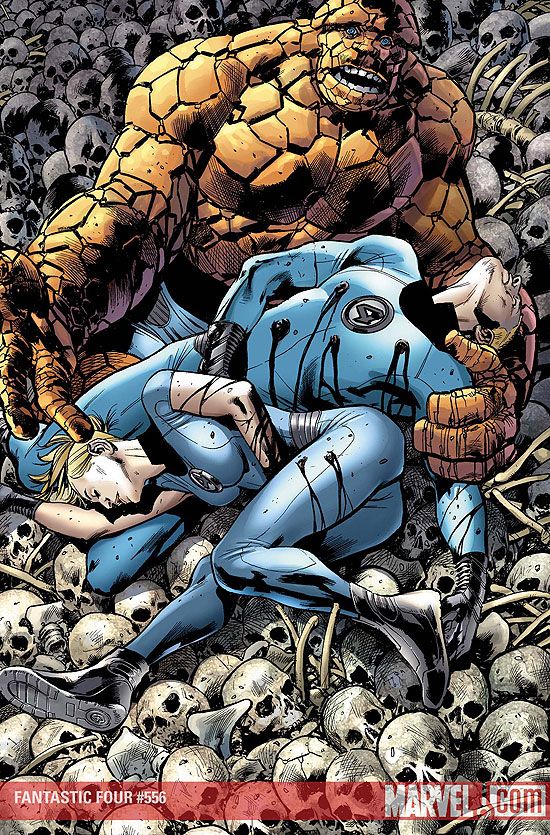Mark Millar and Bryan Hitch's bombastic take on the Fantastic Four isn't terrible, but it reads like a highlight reel of a longer, better story. It's also kind of sleazy, and reading a sleazy story about the Fantastic Four is a bit like thinking about what your aunt and uncle do when the lights go down. That's how "Fantastic Four" #556 made me feel at least, and while I'm glad to see a creative team trying to take the series in a new direction, I'm not sure that this is the best way to go. Out of all of the Marvel teams, the Fantastic Four have always seemed the most wholesome, even with Namor trying to score with Reed Richard's wife and Johnny Storm trying to score with, well, anything. But those moments always felt more like the kind of innocent flirtation you'd see on an episode of "Happy Days" than anything verging on adult sexuality. Millar and Hitch, clearly trying to move past that old-fashioned mentality, give us a Fantastic Four which better represents our overtly sexual 21st century but doesn't have any added nuance. It's not "Happy Days," it's "Pussycat Dolls Present: Girlicious."
The blatant sexuality is most clearly demonstrated in the scene where Johnny Storm walks in on the nude supervillain he just slept with. She's apparently meant to be nude, based on the shadows covering the naughty parts, but it looks as if someone in Marvel editorial ordered an art correction and a tank top was added. Since she's shown putting on a tank top in the next panel, the art correction doesn't make any kind of story sense, but it's Marvel's way of saying, "we're trying to keep this thing from getting too vulgar. I mean, Johnny just slept with the girl he was supposed to bring to the authorities. We wouldn't want you to think he walked in on her naked or something. That would be wrong."
And the entire storyline, which involves Reed's ex-girlfriend's super-genius science project of a parallel Earth, is based on the sexual tension between the former lovers and the jealousy it causes.
It's a hyper-sexualized take on the Fantastic Four, and it just feels off for this particular group of characters.
But, the bombast and the plot excesses do make "Fantastic Four" #556 pretty spectacular. If you can get past the "Maxim Magazine" approach to characterization, there's quite a bit to like about this issue: A giant robot Captain America on a killing spree. Escalating danger, to a nuclear, even transdimensional degree. Forty of Marvel's greatest superheroes lying unconscious in a snow-covered heap. The Thing, standing alone against an unstoppable force. Reed Richards.
But these are moments that don't work as a coherent story, which is why I said they read like a highlight reel. First we hear that forty superheroes have shown up, then when we see them, they are all unconscious (all of them? What are the odds?!), and then we don't see them for a few panels, and then all the heroes are suddenly up and back on the attack (again, what are the odds?!). Millar faced similar criticism for the storytelling in "Civil War," but at least there, in theory, other comic books fleshed out the big moments in Millar's story. Here, Millar is on his own, without any indication of how any of this fits into the rest of the Marvel Universe. It's a grand spectacle, especially with Hitch's impressive penciling, but it's not much substance.
It's also never dull. And that may be exactly what Millar and Hitch are reaching for. Maybe not being dull is enough.

